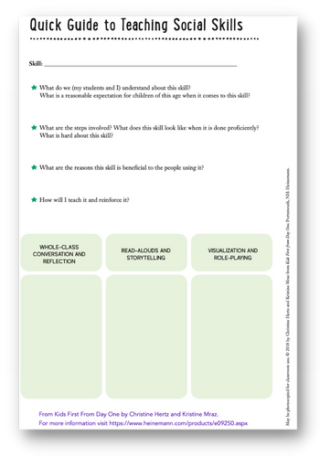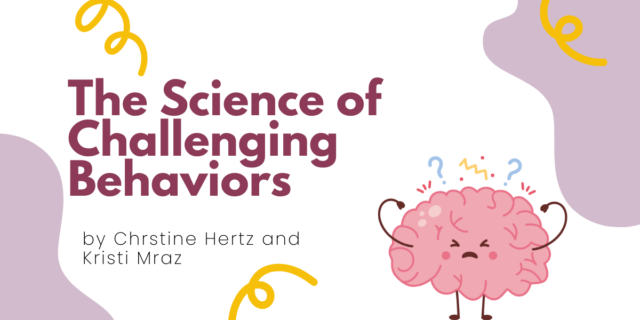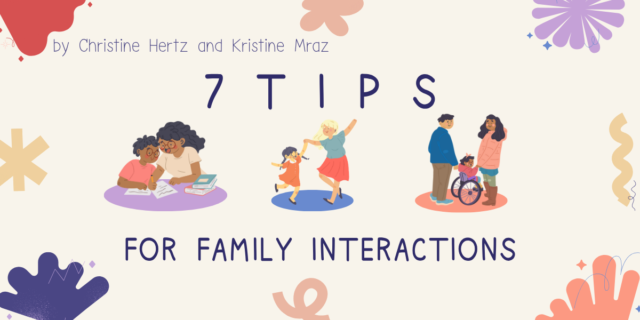
The following is adapted from Kids First From Day One by Christine Hertz and Kristine Mraz.
In the past, maybe even when you were in school, the assumption was that social skills were something you had or you didn’t have, sort of like being born with a certain color hair. Kids were bad or good. Behavior was rewarded or punished. You probably remember some of these things: tickets and class stores, marble parties, timeouts, and notes home that had to be signed. You might remember some of the rewards favorably (that pizza party!) but you might still also cringe with shame over that punishment (you didn’t mean to talk during silent reading, why did you have to write a note to your grown-up that said you did?). The question for us as educators is, did it work? Did we become better community members and better people because of the pizza parties and the time-outs?
Research suggests probably not. Katherine Reynolds Lewis, in her article “What If Everything You Knew About Discipline Was Wrong?” writes “Contemporary psychological studies suggest that, far from resolving children’s behavior problems, these standard disciplinary methods often exacerbate them” (2015). Color charts, clip charts, tickets, and stickers cause more problems than they solve because they don’t address the core issue. Social skills have to be learned, not just enforced. Lewis asks this question in her article: “Are we treating chronically misbehaving children as though they don’t want to behave, when in many cases they simply can’t?” It is essential to reframe your view of behavior as a series of learned skills, much like you may see reading or math. What you see in front of you is what children have learned about existing in a community. Just as children may over rely on sounding out in reading when they arrive at your door, children may have learned social skills that aren’t universally helpful. Skills that help you navigate your family and your community may not serve the same beneficial purpose in school. So, if a child does not yet know how to be successful in school, what do we do? We teach them how.
Social skills can be taught, just like reading skills or math skills. Kids enter schools with differing experiences in academic domains, and it is our job as teachers to assess and teach the necessary skills for success. The same is true for social skills. But how? Often, we hear teachers say that they want their students to be respectful, but respect is really many skills such as listening, following directions, sharing, and turn taking. The first step is seeing a social skill like we see an academic skill: something that can be broken down into several discrete, teachable steps. There are many resources to help you with this (Skillstreaming the Elementary School Child by Dr. Ellen McGinnis [2011] is among the most complete), but it is also something you can puzzle out with colleagues or the children in your classroom. In fact, engaging children in your classroom in each of the questions we pose models the important skills of self-reflection and problem solving. Children bring myriad kinds of expertise to the classroom, and asking for their help and thoughts demonstrates the high value you place on their experience and ability to contribute meaningfully to the class community.
Sometimes as we work to break down social skills, we uncover our own hidden bias and assumptions about children’s experiences. For example, we may assume children feel comfortable talking to adults or believe adults to be trustworthy. We may rely too much on our own experience growing up, or how we parent. In truth, we are all flawed, we all have room to learn, and we can all be better at our social interactions. Don’t despair! Just as in all things, the more we listen, observe, and reflect, the better we will get at breaking skills down and teaching them to children.
How Do We Teach the Steps of Social Skills?
Option 1: Class Conversation and Reflection
First things first, you want to put this to the community. There is no benevolent dictatorship in your classroom; you are the lead learner and so begin that way! Research has found that “Learning is more effective if a lesson or experience is deliberately coupled with time spent thinking about what was just presented” (Fondas 2014). Taking the time to do this might feel stressful in light of all the other demands placed on you in the classroom, but remember, teaching is never about content alone. When you tackle a problem this way, you are teaching the intellectual skills of collaboration, analysis, questioning, clarity, active listening, and reflective thinking—skills that children will use every day of their thinking lives.
How Does Whole-Class Conversation Work in the Classroom?
Whole-class conversations are meant to be conversations between children, with the teacher serving as a rudder of sorts, directing toward key points as needed. More often than not, this conversation is launched with a question or a problem. Sometimes it is the teacher putting it out there, and other times it will come directly from students. Once the question or idea is out there, the conversation exists to problem solve. Children may or may not raise hands (that is a classroom preference), but the key is that the children are talking to each other, not the teacher. The teacher may physically remove himself, lingering behind the students or taking a less obvious seat. The children may move into a circle shape so everyone can be seen. The teacher may pop into the conversation from time to time, but the bulk of the dialogue comes from students. Teachers may help address issues like taking turns or using questions to better understand another person’s point. The social aspects of conversation—looking at the speaker, demonstrating active listening, using names—may also be points of instruction. In the beginning, these conversations may feel chaotic, with a lot (or no) children talking, and the same idea being bandied around for five minutes. Don’t despair! Keep having them, choosing one thing to teach or improve each time you gather for conversations. This can be one of the most impactful ways of building and sustaining your community over time.
Option 2: Read-Aloud and Storytelling
Storytelling is one of the most powerful tools we have for communicating and remembering information as human beings. As psychoanalyst Phillipa Perry wrote in How to Stay Sane (2012): “Our way of being in the world will . . . come from stories that we read and are told to us. . . .” (2012, 95). This is important to know because “our emotional, cognitive and physical response—that is, our typical pattern for dealing with recurrent situations—will come from our own stories” (95). Essentially, we tell stories to ourselves to make sense of what has happened to us, and then those stories, and the stories we read and hear, impact our future decisions, whether or not we are consciously aware of it.
This self-storytelling begins first in our families. Carlin Flora (2006), in her article “Self-Portrait in a Skewed Mirror,” writes “In early childhood, we learn storytelling from our parents. Mothers and fathers who provide coherent, emotion-rich narratives of family life have children who develop more coherent narratives of their own life experience by the end of the preschool years, says Robin Fivush, professor of psychology at Emory University. (Such kids reap additional cognitive and social benefits from narrative wizardry, Fivush notes).” These narratives aren’t necessarily dramatic acts of storytelling; instead, they’re woven into the fabric of the child’s day. From calmly and cheerfully helping children clean up a spill to noticing when they share something with a sibling, children are constructing stories about themselves and the world constantly; we can help children co-construct positive narratives that enable them to act in community-minded, empathic ways. The key here is co-construction. Engaging children in conversations around read-alouds, or having them help co-construct a story about certain behaviors, is what makes this powerful. It is not about lecturing at children, it is about engaging them in a process of problem solving and thoughtful discussion.
How Does Storytelling Sound in the Classroom?
When you craft a story to tell in the classroom, the more explicit the steps and thinking that led to success are made, the more children will see the blueprint to follow next time. A story that sounds like “and then they shared and everyone was happy” skates over the challenging aspects of sharing. If we are using storytelling to teach, we have to make sure the how is explicit. Otherwise it is like teaching reading by saying, “And then you read it. Good luck in life, kids!” This could sound like, “The two friends went to the share chart and decided it would be fair to use a timer to share the special train.” We can use storytelling in visualization and role-play, but it can also be its own stand-alone structure.
How Does Read-Aloud Sound in the Classroom?
In an interactive read-aloud, stopping to ask questions and letting the children turn and talk to each other helps them understand different ways of being in the world. Just like in storytelling, read-alouds and the experiences of the characters serve as guides for when a child is in a similar situation or as a reflection on something that’s happened in the past. Sometimes children find it easier to talk about difficult situations when they occur to characters rather than themselves or their classmates. Stop at key moments in the story and ask questions to elicit this kind of thinking, such as:
|
Option 3: Visualization and Role-Play
You know how when you watch Olympic skiers prepare for their turns, you see them mimicking the movements they will need to make with their eyes closed? Or how basketball players mime taking free throws before they actually shoot the ball? That is all visualization, and it works as well to build mental habits as it does physical ones. When we practice something again and again, even if it is just in our mind, it helps us to build a knowing network around that habit, which makes it more likely we act that way. Sunni Brown, in her book The Doodle Revolution, talks about it this way: “Our knowing network, you may suspect, is that circuit of connected, functional areas in the brain that gives us the feeling that we know something . . . we can strengthen our knowing networks around realities that we want to bring to life—and in doing so, directly impact our potential of moving toward those realities” (2014, 36).
When we role-play and visualize, it is like running mental shooting drills. We train our brain how to react in certain situations before we even get into them. Astronauts do it, pilots do it, sports players do it. And five-year-olds can do it too.
How Do Visualization and Role-Play Work in the Classroom?
Visualization and role-play can exist in a whole-class or one-on-one fashion, depending on the needs of the children. They are meant to be short and often need to be done repeatedly to make an impact on behavior. Visualization might involve children closing their eyes as you tell a story about the social skill you are working on, like sharing or listening. As you tell the story, possibly a real thing that happened, or one co-constructed with children, you are reinforcing the steps you have identified. Let’s say you are working on waiting for your turn; in this story you tell, you will want to embed self-talk (“I may want to go now, but I know I can wait”), strategies for success (“I will distract myself with a song”), and the eventual happy ending (“I waited my turn! That felt so good!”). Resources such as The New Social Story Book (2015) by Carol Gray and The Social Skills Picture Book (2001) by Jed Baker, can help you craft these stories in clear and powerful ways.
Role-playing will also involve the use of a story, but this time children will be the actors. You could set a few children up in the middle of the rug as the others watch in a circle. As you tell the story, they will act it out. When the time for a certain skill comes up, you might invite all the students to chime in and help the actors make the right choice.
Doing this once will have very little impact, but used repeatedly as a quick transitional activity—an end or a start to recess or choice time, or as a break between active times—can have a monumental impact on behavior.
Conclusion
When a child, or a group of children, enters our classrooms with significant needs in social-emotional learning, it can feel overwhelming and absolutely exhausting. As teachers, we can be quick to jump to passing the blame or seeing the situation as hopeless. But just as in reading or math or writing, we can start by getting to know our students, by being careful observers of their strengths and needs, and by finding something very small to build upon. This work can be slow and messy, but helping our students develop these social skills is one of the most important parts of our jobs as teachers.


